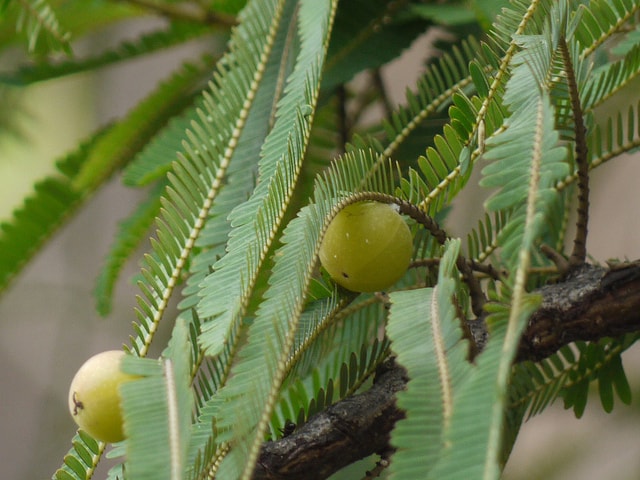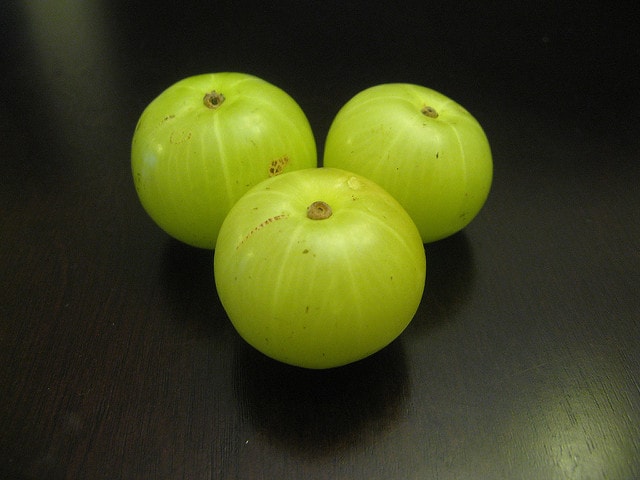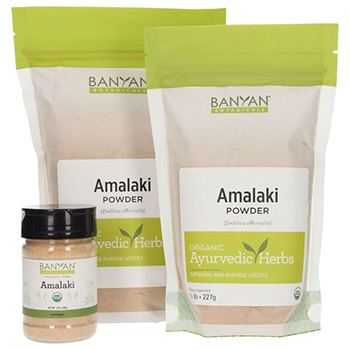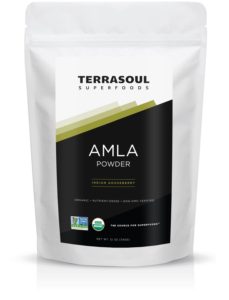I first came across amla – also known as Indian gooseberry or amalaki – when a friend brought back some amla pickles from India. The amla berries were tart, fibrous, and surprisingly tasty. It was only later that I learned about the many amla benefits for health.
What Is Amla?

Amla is the common name for the plant Phyllanthus emblica. It is native to India and most amla still grows there today.
There are a lot of legends surrounding amla, like how Hindu scripts say that amla formed when drops of immortality fell from the heavens during a fight between the gods and demons.
Amla has also been heavily used in Ayurvedic medicine (where it is sometimes called amalaki). All parts of the amla plant are used in Ayurveda, and the plant is considered particularly unique because it contains 5 out of 6 recognized flavors.
Recommended: Bulk Organic Amla Fruit Powder
Health Benefits of Alma
I love it when scientists start to do research into traditional medicines. They are able to prove what we’ve known for centuries: that certain plants have amazing medicinal properties that rival anything we could make in a lab.
In the past decade, there has been a lot of research into the health benefits of alma. Researchers were able to identify certain antioxidants which are attributed to alma’s health benefits. These are:
- Tannins: You’ve probably heard of tannins from red wine, tea and chocolate. Well, it turns out that alma is an even richer source of tannins.
- Ellagic Acid: Ellagic acid is a type of antioxidant which is renown for fighting cancer and is being studied for fighting obesity, inflammation, and glucose metabolism.
- Gallic Acid: Gallic acid is another type of antioxidant found in alma oil. It has antiviral, antifungal, and antibacterial properties. Some of its uses include fighting cancer, treating asthma, and treating sinitus.
- Rutin: Rutin is a plant pigment that acts as a bioflavonoid. It helps the body boost collagen production, improves circulation, and strengthens blood vessels.
- Flavonoids: Amla oil also contains various other flavonoids which are known for health benefits like boosting immunity and preventing the signs of aging.
What is really interesting is that research into alma plant has found new flavonoids that we previously didn’t know about. It is possible that there are many other parts of alma that are providing health benefits – we just don’t know what they are yet!
This goes to show why natural remedies with alma can be so much more powerful than pharmaceutical drugs. Drugs contain just one or two compounds. Plants like amla contain dozens of compounds which work together to boost health.
1. Amla Oil Fights Inflammation
We are finally starting to realize how terrible inflammation is for the body. Inflammation is linked to obesity, diabetes, psoriasis, depression, anxiety, and numerous other disorders.
While I personally love turmeric for fighting inflammation, amla is also a natural remedy for inflammation.
Studies have found that compounds beyond just the isolated antioxidants in amla are working to reduce inflammation. Again, this shows that there are healing properties of the amla plant which have yet to be isolated.
2. Amla Oil for Diabetes
One of the things that amla has been most-studied for is treating diabetes naturally. Studies show that amla can help improve glucose metabolism and prevent blood sugar spikes. Amla oil for diabetes is so powerful that it was found to be as effective as the drug glibenclamide.
3. Amla Oil is Antibacterial
Numerous of the tannins and antioxidants in amla have exhibited powerful antibacterial properties, as well as naturally fighting fungal and viral infections. This makes amla oil a good choice for anti-acne skin treatments. Taken orally, it might help you get over infections faster without having to take harsh antibiotics.
4. Amla Improves Cholesterol Levels
There haven’t been too many human studies on amla oil for cholesterol. However, in animal studies, it was found that amla removes triglycerides from the blood and improves cholesterol profiles. The antioxidants in amla also improve artery and blood vessel health, thus reducing risk of heart disease.
5. Amla Oil Might Improve Hair Growth
Research into amla oil for hair growth is still in its infancy. However, studies do show promising results that amla oil could help prevent hair loss and stimulate growth by improving circulation to the scalp.

6. Amla Oil Balances Hormones
One of the cool health benefits of amla is that it excretes excess estrogen in the body. This quality can help balance out hormones, especially in men and women who are suffering from estrogen dominance.
Estrogen dominance causes symptoms like food cravings, mood swings, depression, and weight gain – so balancing out estrogen is crucial for health!
7. Amla Oil Boosts Immunity
No surprise here: antioxidant-loaded amla is good for your immune system. The powerful antioxidants will destroy free radicals so your body can stay healthy.
8. Amla Oil Detoxes the Body
Because of how much junk food most of us eat, plus all of the chemicals which get into our bodies through pollution and cleaning products, many of us have amassed loads of toxins in our bodies. These toxins cause problems like sluggish metabolism, acne, and even lackluster hair.
Amla oil helps the body excrete these toxins through its powerful antioxidant effect. You will probably first notice the benefits in your skin (which is the largest detox organ) but don’t underestimate the benefits of detoxing the rest of your body too!
9. Amla Oil Prevents Wrinkles
One of the less-talked about benefits of amla oil is that it can prevent wrinkles. This is because amla oil contains vitamin C and antioxidants which promote the formation of collagen and prevent collagen breakdown.
Collagen is what gives our skin elasticity. By the time we are 40, our bodies have lost about over 25% of its natural collagen – which is why problems like wrinkles and even cellulite start to get bad around that age. The secret to preventing wrinkles and cellulite is to make sure your collagen levels stay high – and amla oil can help.
Note that you won’t get the collagen-boosting benefits of amla oil by applying it to your face. Though amla oil is a great moisturizers, collagen molecules are too large to be absorbed through the skin. You’ve got to eat amla to get the benefits!
Using Amla for Health Benefits
Amla oil is best known for its hair benefits. So, almost all of the brands of amla oil you see sold are made specifically for hair.
Hair amla oil should NOT be consumed! This means that you aren’t going to get any of the other benefits of amla oil.
If it is just the hair benefits of amla oil you are after, than Dabur brand amla oil is really popular.
If you want to consume amla oil to get the full range of health benefits, you are best making your own amla oil with amla powder.
Amla Powder
All you need to do is buy amla powder (preferably raw and organic). To use amla powder, you can:
- Add the amla powder to smoothies, or
- Mix the amla powder in oil of your choice and apply to your skin or hair
I recommend Banyan Botanicals Amla powder. It’s raw, organic, sustainably sources and Fair Trade. The powder comes in several sizes and is very affordable. They also have other amla supplements, including superfood blends with amla.
There is also Terrasoul amla powder, which is very high quality, raw, organic, and also happens to be affordable.
Amla Powder Dosage
The most commonly-recommended dosage of amla powder is 1 tsp per day. Whenever starting a new supplement, you should always start slowly so your body has time to adjust.
Start with just ¼ of a teaspoon and then work your way up to a full teaspoon of amla powder per day.
Have you tried amla powder? How did you like it?
Resources for this article:
http://www.sabinsacosmetics.com/pdf/articles/2011-Inhibition%20of%20UV-induced%20ROS%20and%20collagen%20damage%20by%20Phyllanthus%20emblica.pdf
http://europepmc.org/abstract/med/19691935http://www.onegreenplanet.org/vegan-food/amla-berries-a-superfood-for-women-everywhere/
http://www.hairbuddha.net/amla-the-superfood-for-hair/
https://www.banyanbotanicals.com/info/ayurvedic-living/living-ayurveda/herbs/amalaki-amla/
https://www.thieme-connect.com/products/ejournals/abstract/10.1055/s-2006-957754
http://www.sciencedirect.com/science/article/pii/S0889157507001706
https://www.ncbi.nlm.nih.gov/pubmed/20506691
https://www.ncbi.nlm.nih.gov/pubmed/24577384
http://www.healthline.com/health/potential-benefits-of-rutin#ask-your-doctor7
http://healthyeating.sfgate.com/benefits-ellagic-acid-7848.html
http://www.tandfonline.com/doi/abs/10.1080/14786410601124664
http://www.naturalremedies.org/gallic-acid/
https://www.thieme-connect.com/products/ejournals/abstract/10.1055/s-2006-957754
https://examine.com/supplements/emblica-officinalis/
Image credits:
“The pyramids of Amla” (CC BY-NC-ND 2.0) by Kaustav Bhattacharya
“Amla (Gujarati: આમળા)” (CC BY-SA 2.0) by dinesh_valke
“Amla fruit” (CC BY-NC-ND 2.0) by Henna Sooq



